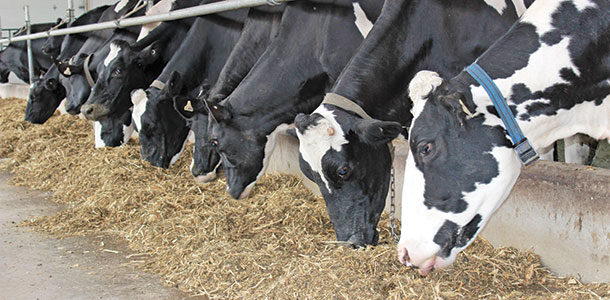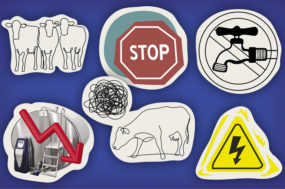In the dairy industry, purebreds have realized significant genetic gain for yields and conformation through intensive selection and existing variation in each breed.
Crossbreeding is generating interest with some producers as an alternative selection and mating option to help reduce inbreeding and minimize fertility and reproduction problems.
When two animals of different breeds are mated, the first generation is expected to show qualities superior to the average of its parents.
We refer to such phenomena as hybrid vigour. Capitalization on hybrid vigour is greatest in the first-generation cross (F1), and effects are not transmitted from one generation to the next if no other further crossing is conducted with another breed.
Managing crossbreeding and different generations of crosses can therefore become difficult and complicated.
Research … and reality
Researchers at the University of Guelph investigated the performance of progeny of a group of cows, mated to different breed sires, over the course of five years.
Results showed that crossbred Holsteins produce less milk but with higher fat and protein components versus a purebred Holstein cow.
The quality of mammary system was negatively affected in the F1 generation when Holstein females were crossed to other breeds.
Crossbred cattle had deeper udders with narrower and lower rear udder attachments. Crossbred cattle were smaller in stature and had an overall lower conformation score.
However, producers who participated in the pilot project noticed improvements to fertility in terms of higher reproduction rates, shorter gestation lengths and lower stillbirth rates due to smaller calves and slightly better calving ease.
Another study conducted in California showed similar results. They reported that improvements to performance were contingent upon using the best sires of each breed for each particular trait.
Therefore, the study recognized the importance of using superior sires in each pure breed to achieve maximum results in the F1 generation after crossing.
What tools can we use to maximize results in purebreds?
Crossbreeding has some benefits, but the main advantage can be overcome by adjusting management practices and improving selection strategies for a few key traits such as health and fertility.
It’s always important to weigh risk versus reward, and in this instance, the most significant risk is: the unknown. The Holstein breed has a great deal of genetic diversity; it is easy to select an extreme sire (very good) for a certain trait for maximized opportunity for genetic improvement.
Decisions to crossbreed may slightly improve the performance in one generation, but these results are likely not genetic (we have no way of estimating) and are definitely not cumulative in future generations.
The main advantages to breeding using pure Holsteins are having a large and variable population of animals to select as mates for all traits and being able to capitalize on the use of genomic technology to improve the accuracy of selection and rate of genetic improvement. With purebred breeding, all of the producers’ and industry’s efforts are put into developing one breed.
Thanks to phenomenal breed improvement tools (such as performance recording, collaborative data exchange and genetic evaluation) and decades of intense selection, genetic gain in the Holstein breed has been spectacular.
We have sophisticated tools that allow for accurate identification of individuals that rank among the best for particular traits of interest.
Direct selection is possible for important economic traits like daughter fertility, herd life and somatic cell score. These traits are also emphasized in the national selection index (LPI) for maximized gain.
They tried it …
Ferme Breault & Frères Inc. is located in Compton, Quebec. The farm is family-owned with five shareholders, has quota for 425 kilograms butterfat and a total of 725 head with 350 milking cows.
Their average annual milk production is 12,500 kilograms; cows are milked three times a day.
According to Charles, one of the shareholders, the farm’s main breeding objective is to strengthen the herd’s genetics with regards to functional traits. At Ferme Breault, herd life, somatic cell score and calving ease are of utmost importance.
With the experience they have gained over the years, the Breaults can testify the kind of cow they are looking for is a Holstein.
They prefer working with cows of moderate size and with proportional balance of all parts – the kind of cows valued by the Canadian classification system.
For them, the upside of working with this kind of animal is that they will have fewer feet and leg issues and a better feed conversion with similar milk production.
In the early 2000s, the farm was tempted by the benefits of crossbreeding. At that time, they were persuaded to develop a good crossbreeding strategy in order to improve several herd management deficiencies and to develop a “solid and rustic” type of cow.
Also, the promises of hybrid vigour leading to easier calving were a reason to consider crossbreeding.
At first sight, the resulting crossbred heifers had relatively desirable type and were meeting their expectations.
This crossbreeding strategy (producing an F1 generation) seemed to have worked and showed promise for success; however, with time they realized that the biggest drawback was poorer milk production.
For the Breaults, a profitable business model needed maximum milk production, i.e., butterfat kg per cow per day. They believe this goal remains too difficult to achieve just through hybrid vigour.
Moreover, the Breaults believe a cow must have a strong mammary system as well as solid feet and legs to have a long herd life – which their crossbred cows simply did not possess.
Today, the shareholders say they are convinced that rigorous selection of Holstein sires can improve their genetics easier and faster to the level they desire.
Nothing is more reassuring for the Breaults than their genetic line-up and to be able to predict what the next generation of replacements will bring to their herd.
Moving forward, the Breaults will be considering the use of genomics as an additional tool to help advance their herd forward with quality Holsteins in which they have invested their passion, their time and money to select.
In fact, genomic testing their replacements will ensure their selection decisions for both males and females will be more accurate and include families with a higher genetic potential. They are convinced this tool’s added accuracy is essential to the genetic evolution of their herd.
Need advice?
Producers who are experiencing difficulties with management and selection and wish to make improvements should first start by identifying the herd’s main goals.
Once goals are defined, it is easier to set criteria for selection to improve the herd. It is also important to differentiate between herd weaknesses that can be improved through changes to management or which can be improved significantly with the help of genetic selection tools.
Canadian dairy breeders have a wide selection of breed improvement tools at their disposal to increase potential in their herds.
Be prudent and ask for advice from the many resources at your disposal within the dairy industry: Professionals are there to guide and help you reach your objectives. PD
Jeanette Van der Linden is an extension and education specialist for classification and field services with Holstein Canada. Valérie Tremblay is an agriculture training and extension coordinator with Holstein Canada. Jean-Philippe is a Holstein adviser with Holstein Québec. He can be reached at
References omitted due to space but are available upon request. Click here to email an editor.
PHOTO
The Holstein breed has a great deal of genetic diversity: it is easy to select an extreme sire (very good) for a certain trait for maximized opportunity for genetic improvement. Photo courtesy of Holstein Canada.








